Casting metal parts has been around for thousands of years. Today modern casting is the backbone of countless industries, from automotive and aerospace to energy, art, and jewelry. Due to its importance, a wide variety of technologies have been developed for metal casting, and 3D printing is the latest to make its mark by delivering faster, more accurate, and less expensive patterns, cores, and molds.
Whether it’s sand casting, investment casting, die casting, lost-wax casting, shell molding, or any similar method, 3D printing plays a part. Most often, it’s a complimentary role within traditional foundry processes, helping to boost efficiency, enable innovation, and cut costs. For a wide range of regulated industries, such as automotive, aerospace, and defense, where moving to metal 3D printing would trigger new rounds of certifications, incorporating 3D printing into traditional metal casting brings huge efficiencies without new hurdles.
Here, we explore the technology behind 3D printed patterns, cores, and molds in use today at foundries worldwide, plus the top 3D printers for the job, and examples of companies turning to additive manufacturing to optimize and modernize their metal casting.
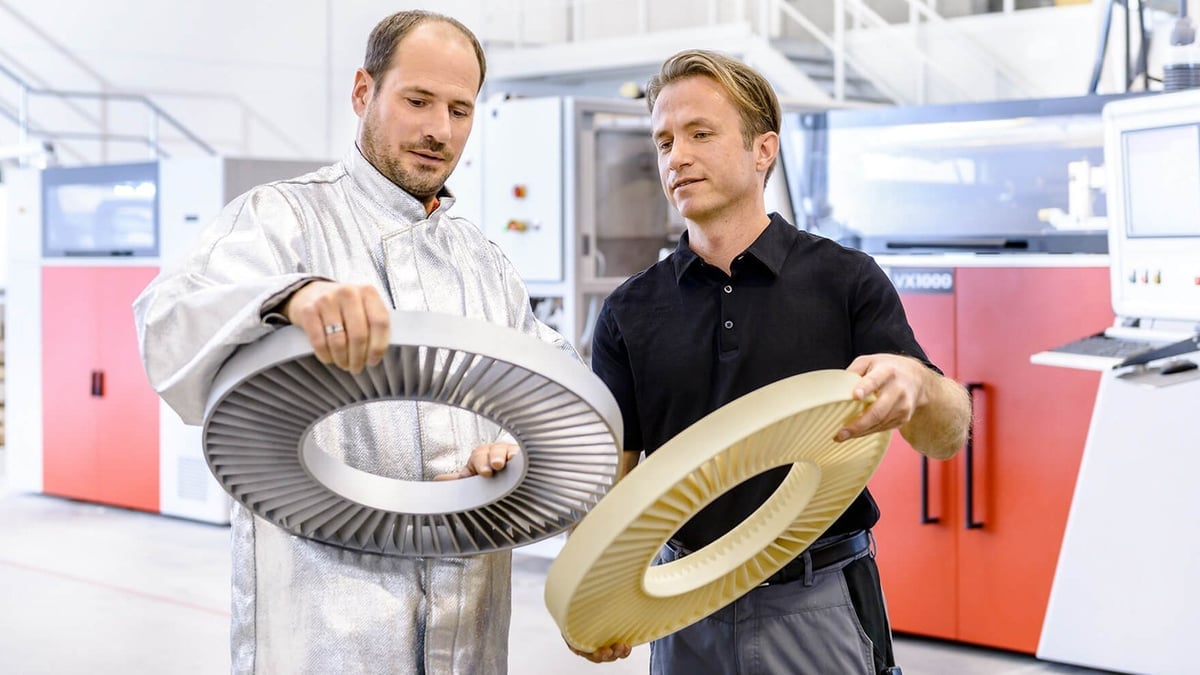
3D Printing Patterns
Before the rise of 3D printing, manufacturers had limited options for producing master patterns, which are the replicas or models used to create the mold cavity into which molten metal is poured. CNC machining is the most common industrial method and works with a variety of plastics and metals. For jewelry and other arts, hand-carving wax or wood is still used today.
However, 3D printing patterns in plastics or special casting materials is a far faster and less expensive method with equal accuracy, widely adopted in various industries. 3D printing can produce patterns in geometries, such as internal channels and thin walls, that are difficult or impossible to machine or require time-consuming secondary assembly or milling to produce the final product.
3D printers work directly from a computer-aided design file and can be easier to use than a CNC machine. You can expect to produce little to no waste and have batches of prototype patterns and final patterns in a wide range of materials in as little as a few hours, vastly accelerating product development.
Advantages of 3D Printing Patterns
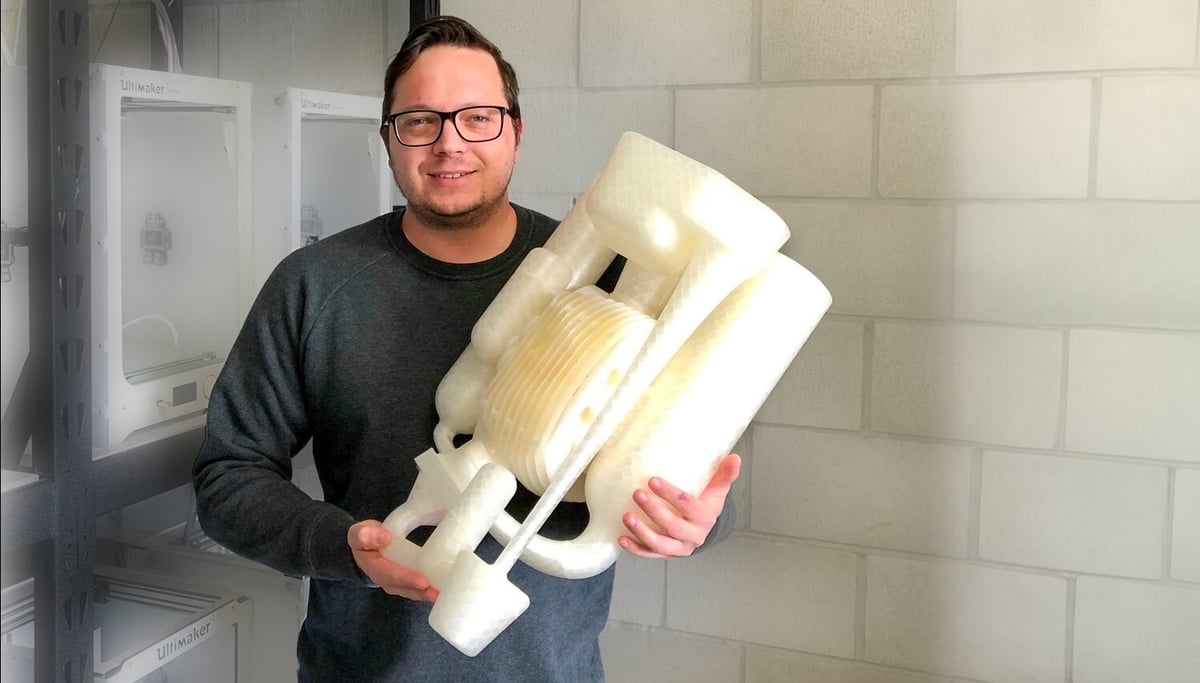
We’ve mentioned the major advantages of 3D printing your patterns, but let’s look a bit deeper.
- Design Freedom. 3D printing can create complex, thin-walled geometries in a single step without any tools, assembly, or post-processing. There are no master craftsmen or artisans required to sculpt or carve patterns, and anyone with CAD design skills can create patterns that can be scaled to virtually any dimension.
- Eliminate Tooling: Patterns are printed directly from the digital CAD file eliminating any other molds or tools. There’s no need to use multiple machines, each with its dedicated staff to create the master pattern.
- Production Speed: Traditional pattern production processes can take weeks, months, or years depending on the complexity. They require intensive manual labor as mentioned above. With an automated 3D printing process, you can print your patterns (several versions at once) in a matter of hours or days. And if the pattern ends up not working, the digital design can be easily modified and printed again and again.
- Low Cost: All you need to 3D print a pattern is the digital file, printing material, and a 3D printer. A 3D printer also doesn’t need to be monitored as it works, and you might not even need to buy one, just look to third-party 3D printing services, such as Craftcloud, which are especially economical for a batch or prototype patterns.
- Raw Material and Waste Reduction: Since 3D printing is an additive process, all you need is the material that goes into the final printed pattern product. Compare this to machining, where you’re whittling down a large chunk of material, for example aluminum, into the desired shape creating aluminum scrap.
- Eliminate Model Inventory: Especially for heavy industry, master molds for industrial parts are often stored in case a replacement part is needed. Using digital files eliminates the need to store models since a new one can be quickly and cost-effectively 3D printed anywhere.

3D Printers For Patterns
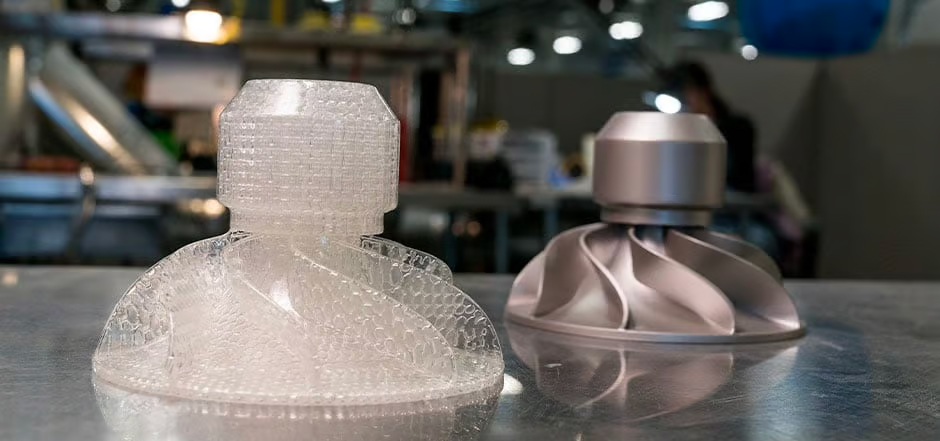
In theory, practically any 3D printer can be used to make patterns as long as the materials used has mechanical properties that prevent it from warping, bending, cracking, or breaking in whichever mold-making process it’s subjected to.
For this reason, we’re not featuring the top 3D printers for pattern making since the selection is so broad and depends on your application and budget. There’s also a wide range of on-demand 3D printing services that will convert your digital file into a pattern and advise you on the best material.
There are, however, some specialty 3D printers for patterns (such as wax 3D printers) and 3D printer makers that focus on patterns by offering specific materials, workflows, and, in some cases, software.
One example is 3D Systems, which offers a process called QuickCast with a special material, Accura Fidelity, on its stereolithography (SLA) 3D printers featuring a build style available with the company’s 3D Sprint Pro additive manufacturing software. The company says this process creates complex master patterns in hours that are large yet lightweight and strong enough to perform in the investment casting process. 3D Systems also makes wax 3D printers for industrial pattern-making and has bundled all of its investment casting methods and resources into an offering called the Digital Foundry.
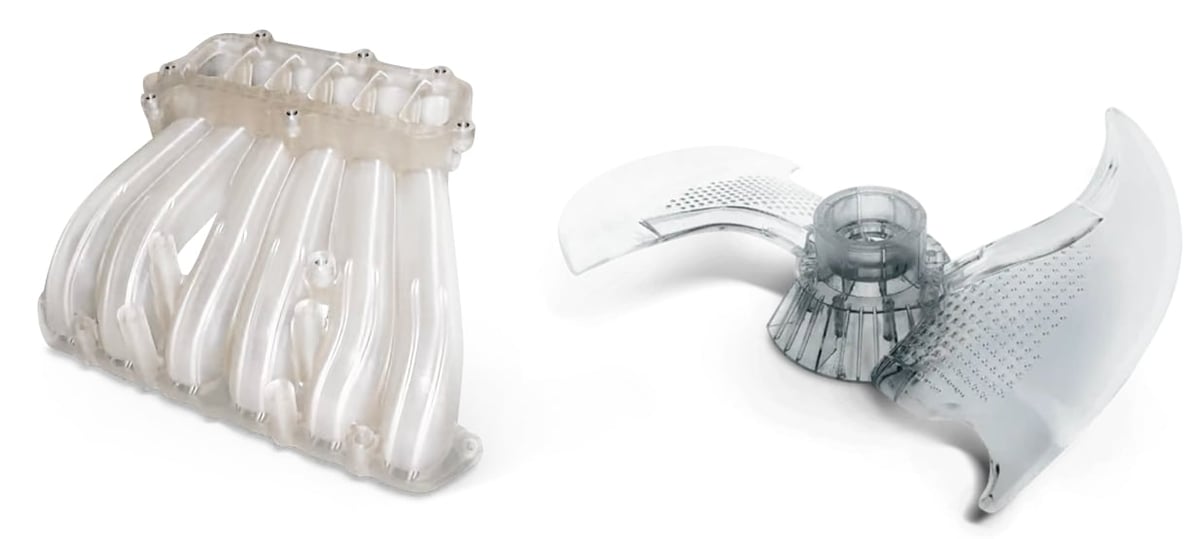
Voxeljet is another 3D printer maker with a special focus on investment casting applications. Its range of compact to large-format binder jetting 3D printers uses a special material for investment casting. The company offers webinars on pattern making and a print-on-demand service.
3D Printing Castable Materials
Materials for pattern-making come in a wide variety of filaments, resins, and powders. But just because a material will melt at 400ºC, like PLA, doesn’t mean it’s right for patterns. Some materials may have additives that could leave behind a residue or particles in your mold. Look for specially made materials that boast a clean burnout and low ash residue. You’ll also want to look for the temperature range at which it will burn out, for example, between 400ºC and 850ºC.
Materials commonly used in 3D printing casting molds include:
- Polymethyl methacrylate (PMMA)
- Polyvinyl butyral (or PVB)
- Polyhydroxyalkanoates (PHA)
However, many resins may not list their ingredients, so it’s best to ask the manufacturer about the material’s applications.
Companies 3D Printing Patterns
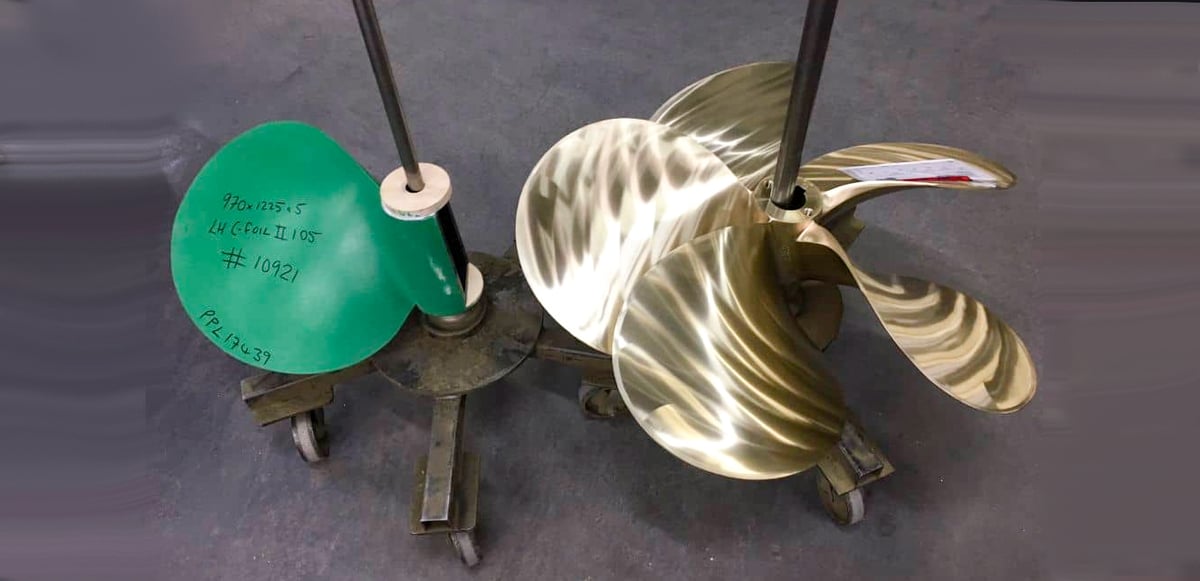
Dozens of industries have already moved to 3D printing patterns to provide high-quality prototypes and molds. Especially for innovative companies that strive to offer new products and designs, the traditional machined pattern-making process has proven to be cost-prohibitive and time-consuming.
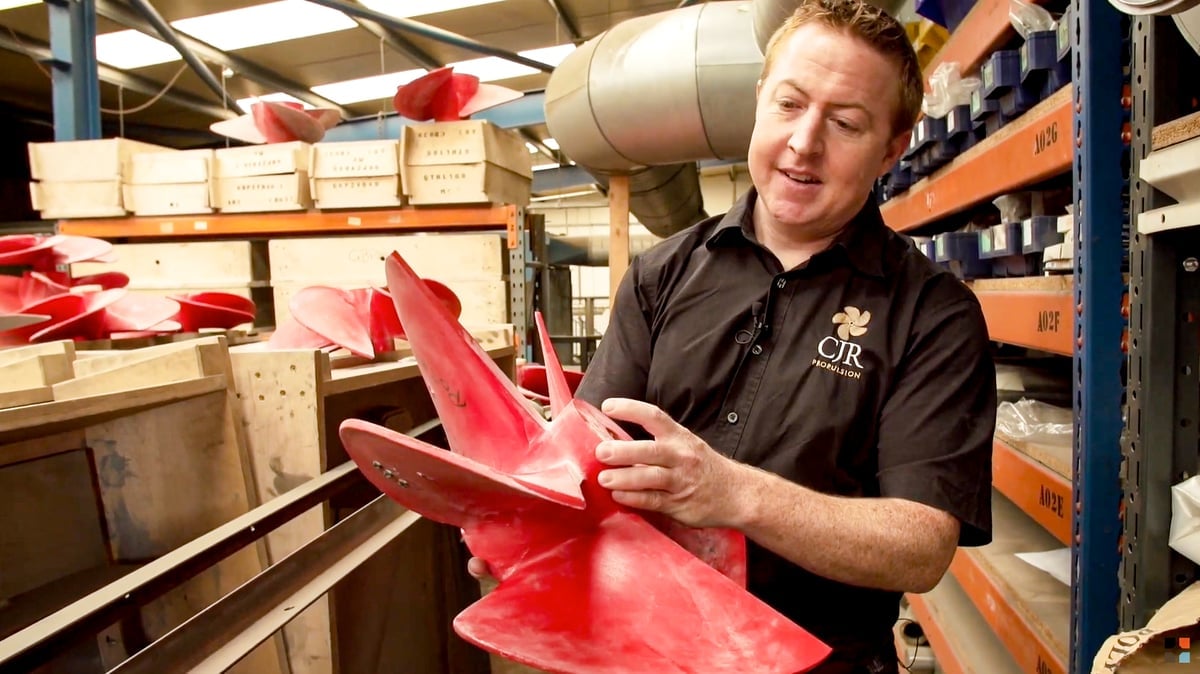
For example, CJR Propulsion, a UK-based company that designs and manufactures custom propellers for luxury yachts and marine vessels, stays competitive in the market because it develops new propeller designs through multiple iterations that are printed out on its BigRep FDM 3D printer.
“This is something new that we wouldn’t have been doing without a 3D printer because it’s so cheap and easy to make the patterns that we can experiment with many different designs,” says Simon Lewis, technical director at CJR Propulsion. Patterns take hours to create rather than days and require sanding and coating before being used in the sand molder.
Because the patterns are printed with high-impact resistant materials, they have the mechanical properties to withstand high pressure and abrasion of the sand molder.
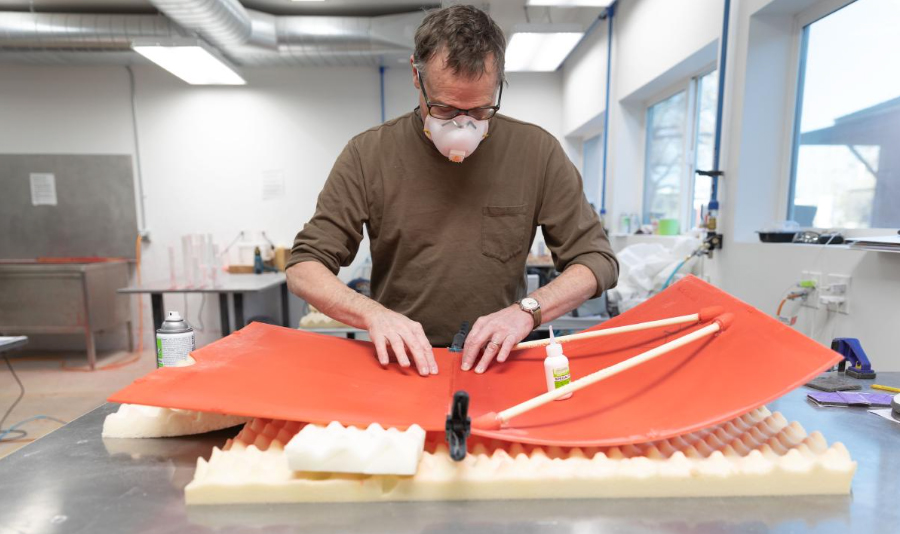
A recent example of the flexibility of 3D printing patterns was used in the bronze statue called The Embrace in Boston. Walla Walla Foundry in Washington State started with a digital model of the statue and scaled it up to its full 8-meter-wide size, then divided its surface into 608 thin pieces. Each piece was 3D printed in a special plastic on the company’s Voxeljet 3D printers, then dipped in a ceramic slurry to form a mold. After drying, the molds were heated to melt away the plastic leaving a finely detailed thin mold. Up to 20 pattern pieces could fit in the Voxeljet VX1000 printer at a time, accelerating the entire process.
Because the artist did not create a life-size model of the sculpture, 3D printing was the only way to produce the artwork.
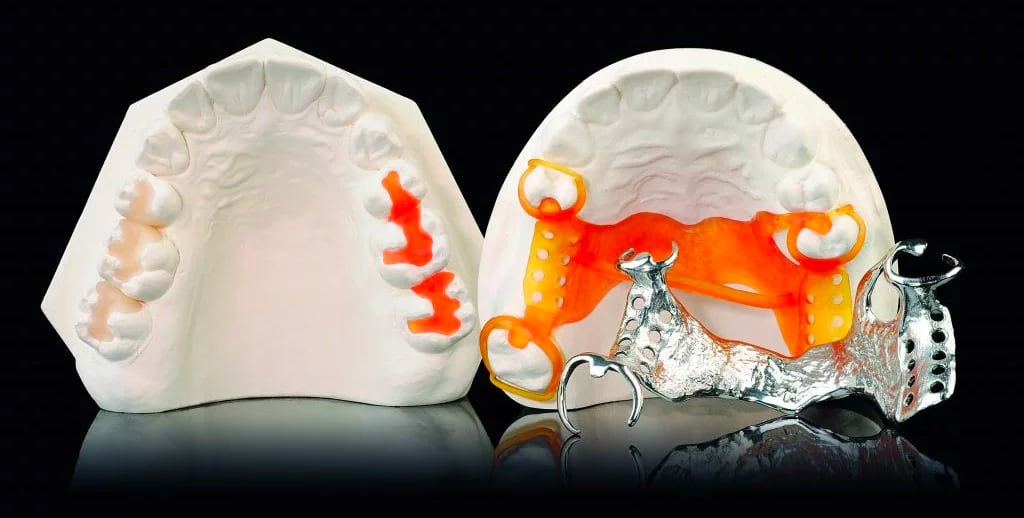
3D Printing Sand Molds & Cores
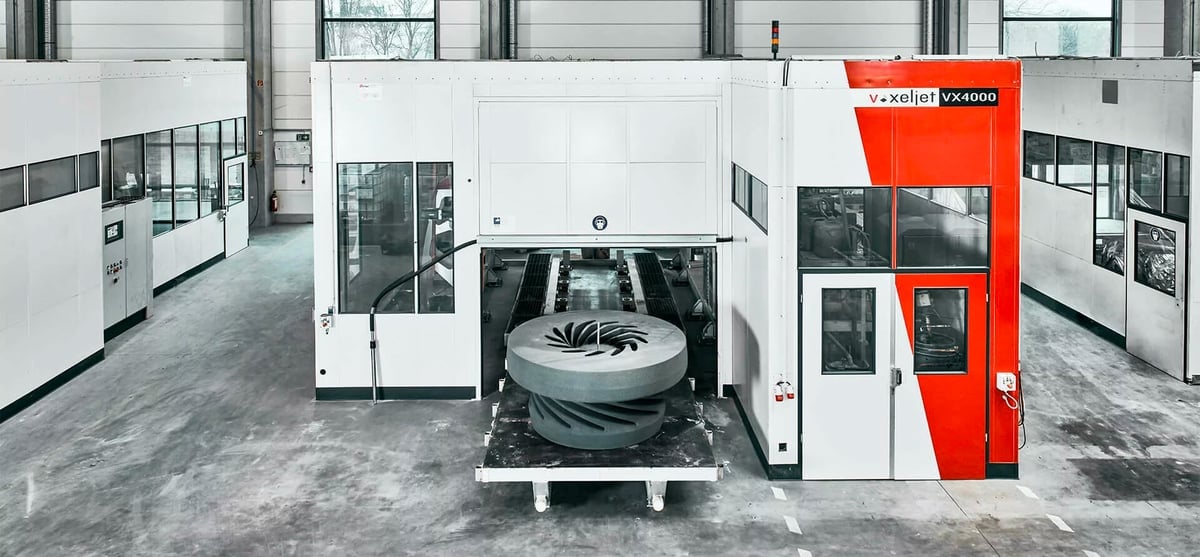
Sand casting has been practiced for centuries for the cost-effectiveness of the material, flexibility in design, and suitability for producing both small and large castings. Traditional sand molds, used in a wide range of industries, including automotive, aerospace, construction, and general manufacturing, are made using a pattern that’s then pressed in sand. But what if you could just 3D print the sand mold?
For prototypes that may completely change or for reducing design risks without investing in tooling and pattern making, 3D printing sand molds is a game-changer.

3D sand printing (3DSP) typically uses binder jetting technology. This type of 3D printing process starts with a digital file of the mold that’s then translated into layer-by-layer build instructions for the printer. Various CAD software programs have tools that enable you to generate a digital mold from your digital part file.
Inside the printer, the recoater applies a thin layer of sand on the building platform that’s then selectively bonded by a liquid bonding agent or “glue”. This process is repeated until the mold is built up. Once printed, the mold is removed from the bed of the loose sand and can receive optional surface finishing. There’s also often a step to cure or harden the mold, which is either heat or microwaves.
Several products are usually produced in a single job box to make the best possible use of the build space.
Top Attributes of 3D Sand Printing:
- Large parts. The build volume of a sand 3D printer far exceeds any other 3D printing technology.
- No support structures. Materials not 3D printed with the binder act as support for later layers.
- Little material loss. With no supports needed, no material is wasted, and the leftover material in the print bed can be reused.
- Inexpensive printing material. 3DSP uses the same sands and binder agents as traditional sand mold making
- Speed. In addition to skipping the pattern step, sand molds can be printed in just days.

Who’s Using 3D Printed Sands Molds and Why?
When the US Navy was looking for the most efficient way to produce large metal parts, such as gearbox housings for legacy aircraft, it turned to 3D sand printing because the hard tooling didn’t exist anymore, and time estimates to recreate it was years. Sand molds took only months.
The Navy, for this part program, opted not to directly 3D print the legacy parts in metal because they would be subject to lengthy airworthiness testing before they would be allowed to fly. Because metal casting is how the original part was manufactured, there was no airworthiness testing required when using the 3D printed sand mold.
There’s virtually no limit to the legacy, historic, or unique metal parts that require remanufacturing. OK Foundry, in Richmond, Virginia, focuses on casting specialty metal parts ranging from turn-of-the-century engine blocks to antique elevator parts, using 3D printed sand molds. The company has used Solidworks CAD software to design 3D printed sand molds since 2012.
Speed is one of the primary benefits of 3D printing sand molds. One example is a broken-down icebreaker in Canada that was used to keep critical shipping lines open. Due to an engine defect, the icebreaker was stuck near the coast of Canada. The usual delivery time for the required component was around five months which meant considerable financial problems for dozens of companies. Thus, a fast availability of a spare part was the top priority for the repair of the ship. With a 2D design plan of the part, Finish foundry Hetitec Oy, transformed it into a 3D CAD file. The actual production started with 3D printing the sand molds on Monday, and by Friday of the same week, the machined, finished casting was already on its way to Canada.

For General Motors’ relatively low-volume and unique luxury car, the Cadillac Celestiq, the underbody is cast from 51 3D printed sand cores. The novel underbody structure consists of six large precision sand-cast aluminum parts, replacing up to 40 components.
In order to realize the complex structures as economically and lightly as possible, US-based Tooling & Equipment International (TEI) uses 3D sand printing for all inner cores. This allows stiffening features to be incorporated into the hollow sections, which is not economically feasible with conventional manufacturing, the company says. TEI prints these using the Voxeljet VX4000 printers, each of which prints hundreds of inner cores for several vehicle sets in just one night.
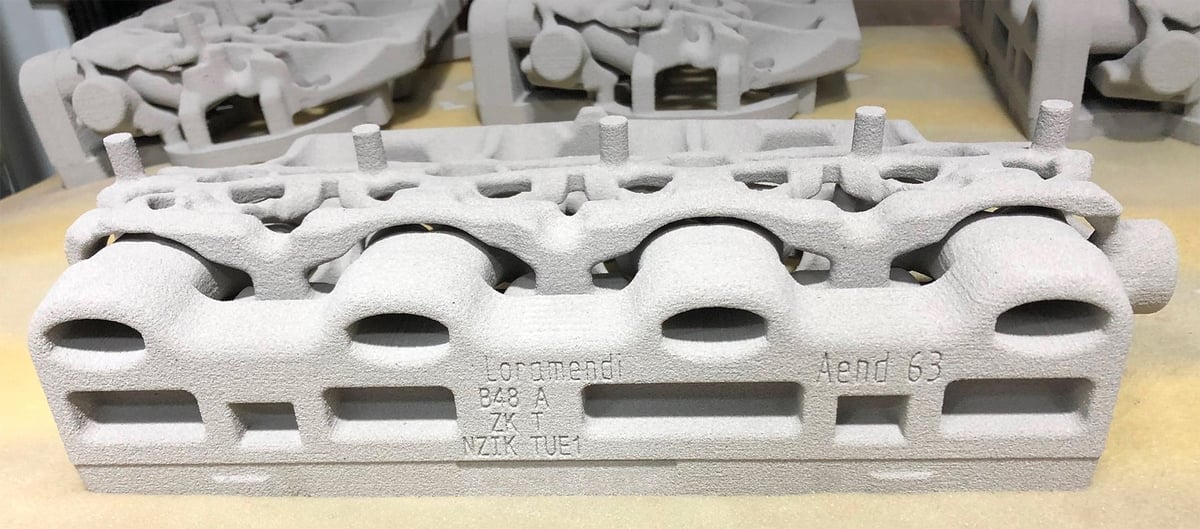
Voxeljet also recently partnered with BMW to deliver a custom solution for the serial production of 3D printed sand cores used in the production of the BMW B48 engine. Instead of the previous nine complex individual parts, BMW can now produce the core entirely in one piece using 3D printing. This way, the efficiency and consumption of the engine can be optimized due to the complex design of the sand core component, the company says. “No other technology made it possible to mass-produce such a complex element in a cost-efficient manner.”
Top 3D Printers for Sand Molds & Cores
VoxelJet
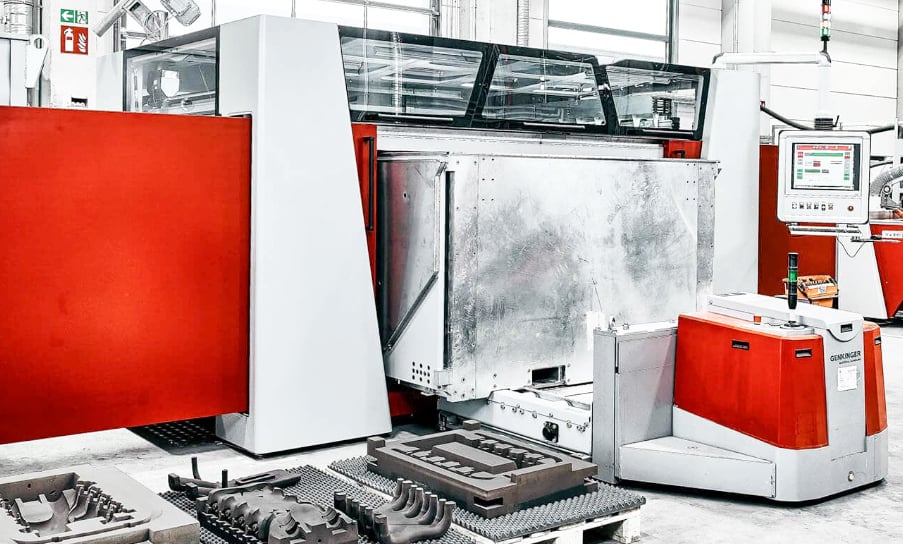
Voxeljet offers one of the world’s largest and most powerful 3D sand printing machines for large components or large batches of small components. The company offers sand 3D printers in four sizes using binder jet 3D printing technology.
Voxeljet uses common foundry materials, including sand and binders, to ensure seamless integration into traditional production processes. In June 2023, the company launched its cold IOB (inorganic binding) technology so molds and cores no longer need a microwave post-printing treatment, which reduces costs. Voxeljet says this process reduces emissions and improves working conditions in foundries because only water vapor is produced during casting instead of harmful gases. The process is available now on the VX1000 and VX1000S printers.

Kocel

Kocel produces dozens of sand 3D printer configurations providing a wide range of sizes and features.
Kocel sand printers are made in China but available worldwide. They feature one-click printing and a range of sand materials, as well as environmental considerations including air filtration, air conditioning, low noise, and dust-free.
ExOne, a Desktop Metal Company
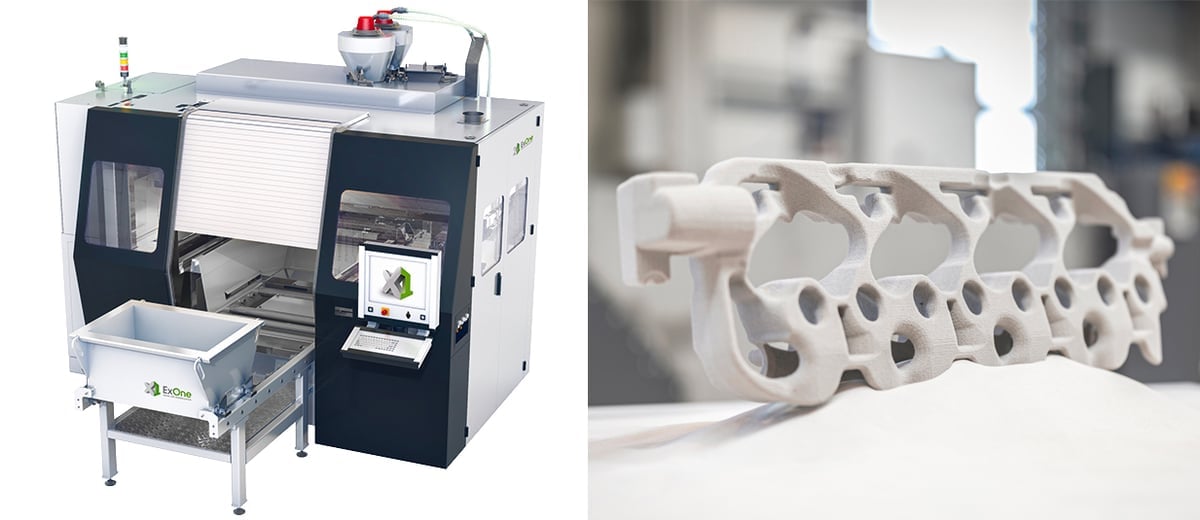
Sand 3D printers from ExOne, a Desktop Metal Brand, support sand casting applications across industries for prototyping, serial production, and parts on demand. The systems have a fine layer height of just 200 microns and can print with natural and synthetic sands. Nearly 30% of the sand from one job can be reclaimed for use in the next print.
Like the Voxeljet printers, ExOne systems use binder jet technology.

Eplus3D

The EP-C7250 from Eplus3D uses what the company calls “resin sand” to print sand molds for metal casting of parts such as engine blocks, cylinder heads, turbines, and impellers with complex structures.
The EP-C7250 is not a binder jet 3D printer, but instead, it uses selective laser sintering (SLS). It offers a huge build size and can rapidly print sand casts and molds from polystyrene, powdered wax, or resin sand to create molds for the traditional casting process. The EP-C7250 can print layers with a minimum thickness of 80 microns which can be adjusted based on a certain application.
The printer can be used with an optional powder cleaning station, sand blaster, powder mixer, forklift truck, and vacuum cleaner.

CMET
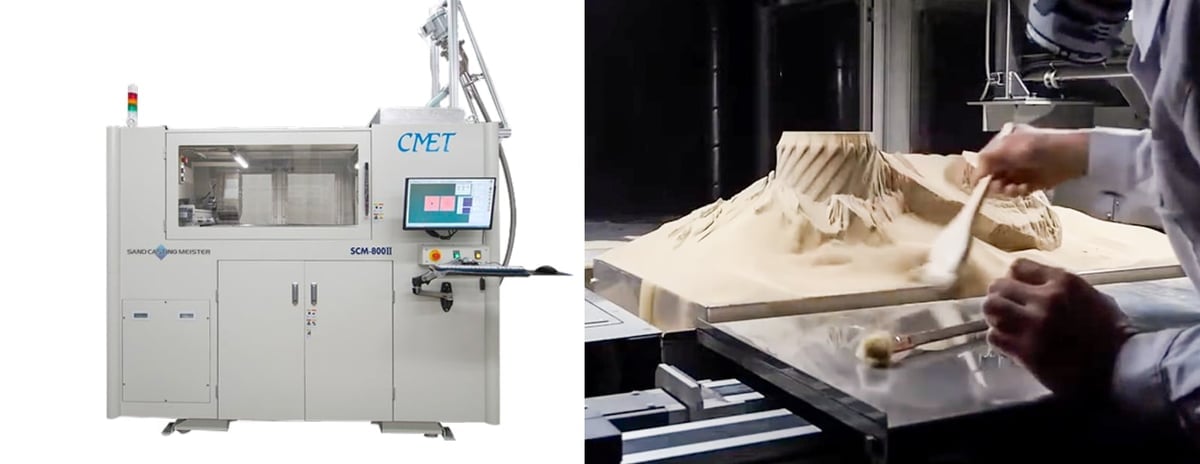
CMET is a Japan-based company that offers two sand 3D printers using binder jet technology. The company claims its units are the fastest. The system uses a dry artificial sand (G-CCS), and uncured sand can be recycled repeatedly. There’s also a room-temperature curing process, eliminating the heat treatment, so molds and cores can be used for the casting process immediately after sand removal.
CMET also offers a sand mold 3D printing service.
3D Printing Ceramic Molds & Cores
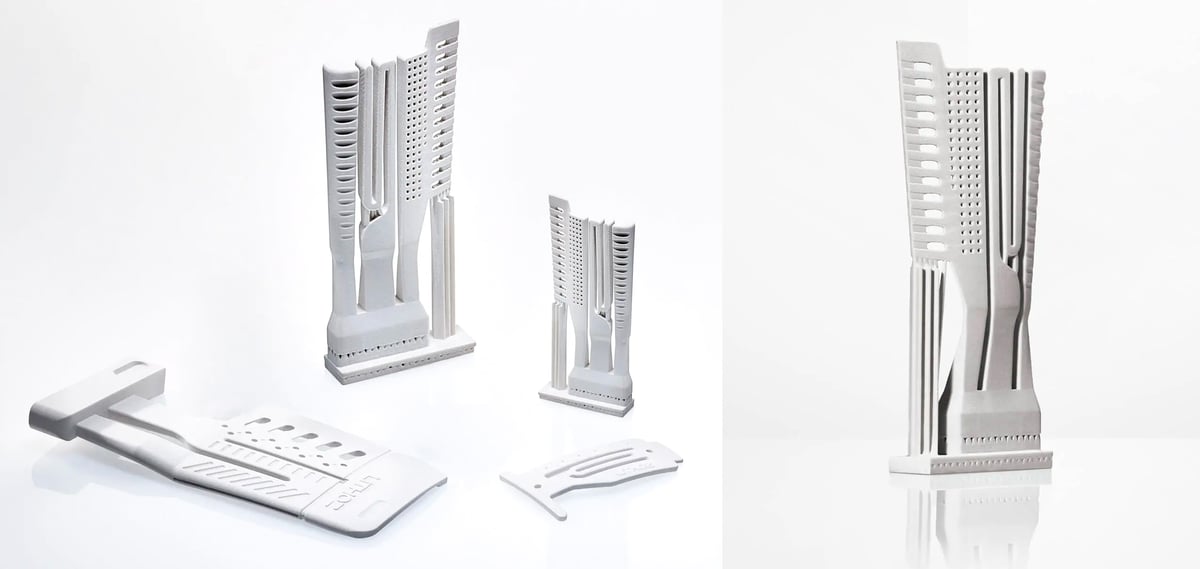
Similar to 3D printed sand molds, directly 3D printing ceramic molds, shells, and cores, eliminates the pattern step entirely. Ceramic molds and cores provide the possibility for more details and internal structures in a single mold than sand molds. It also can afford more shape complexity than the traditional ceramic shell preparation process involving a wax pattern.
The traditional metal investment casting industry uses wax molds dipped in ceramic silica suspensions, then dried, de-waxed, and heat-treated to form the final ceramic shell into which metal is poured. A ceramic 3D printer can print the shell using a silica-based ceramic slurry, removing the pattern step, but the process still requires post-processing steps, including firing the shell.
Although there are research reports pointing to the viability of this method, 3D printed ceramic shells are not widely used in industry yet. The relatively high cost of the 3D printable ceramic material and the post-printing sintering process has restricted wide adoption, but there have been applications in manufacturing.
One start-up in this niche offers a “CAD to casting” process that can produce ceramic shells with integrated cores. The company, Atlanta-based DDM Digital Foundry, offers a proprietary printer, material, and a method called large area maskless photopolymerization (LAMP).
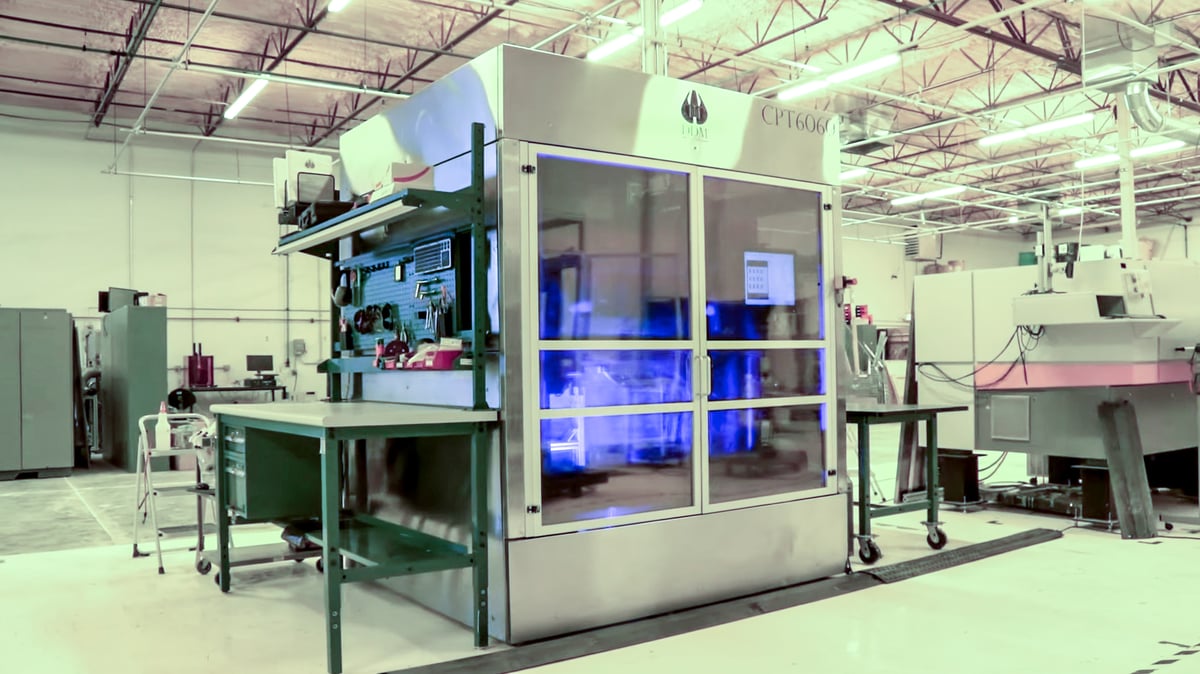
DDM is focused on disrupting the aerospace, turbine, and defense markets by delivering a method for casting that is faster and cheaper than the typical 18-24 month process. DDM founder Suman Das says the first seven steps in the traditional 12-step ceramic shell production process cause up to 90% of the scrap waste and up to 50% of the cost. DDM eliminates the first seven steps in traditional investment casting with a single 3D printing step, he says. DDM completed a pilot project with SpaceX to produce ceramic cores for casting various rocket engine components in SpaceX’s own on-site foundry. A second pilot with Husky, one of the largest injection molding companies worldwide, produced tooling with complex internal channels that cannot be made by any other means.
Although 3D printing ceramic shells are just getting started, a more common use of 3D printed ceramics in metal manufacturing is as mold cores, specifically for the blades in turbine engines. You can read more about why this targeted application is benefiting from 3D printing in this case study by 3D printer maker 3DCeram, but essentially, as turbine blades become more elaborately designed with internal features to boost efficiency, reduce fuel consumption, and lower greenhouse gas emissions, the mold cores become more complex, costly, and time-consuming to produce. Companies such as Avignon Ceramic in France, CeramTec in Germany, and US-based Perfect3D now specialize in 3D printing ceramic cores for turbine blades.
Ceramic 3D printer maker Lithoz says its technology is also highly suited to create the type of precise and complex aviation casting cores with intricate channels, such as for aircraft turbine blades with internal cooling channels. 3D printed ceramic casting cores allow for much better design freedom, the company says.
Top Printers for Ceramic Molds & Cores
3DCeram

With over 15 years of expertise in ceramic 3D printing, French company 3DCeram offers seven machines and on-demand and serial production services, including materials consulting and R&D for new parts and components. The company developed a proprietary “support-link-free” technology that is said to leave no support marks on any surface. The method is a top-down stereolithography so the tray moves down as the part itself is built from the bottom up.
The smallest of the company’s printer line is the C101 Easy Lab designed for research and prototypes. It uses a UV Laser to cure layers of ceramic resin to a very small 0.020 mm layer height. The rest of the 3DCeram fleet covers a wide range of sizes up to large-scale production and multi-material 3D printing.
3DCeram offers several oxide and non-oxide ceramic materials and will custom-create ceramics.
In late 2022, 3DCeram acquired an FDM printer startup Tiwari and plans to expand its ceramic know-how to FDM printing ceramics with filament.
Lithoz
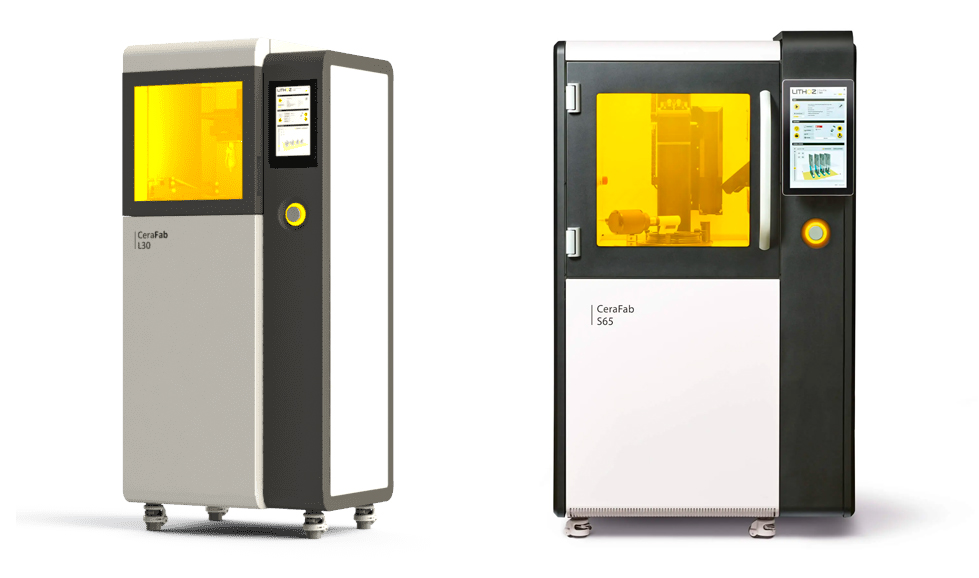
Additive manufacturing company Lithoz focuses exclusively on ceramics offering seven machines and a wide range of materials.
The company’s CeraFab system, comes in five models (L30 Lab, S25, S65, S65 medical, and S230), which differ in resolution and build volume. The CeraFab Lab L30 ($158,000) is a shop floor-friendly 3D printer with the full power of Lithoz’s original CeraFab 7500 condensed and specifically developed as a starting point for ceramic 3D printing. The company’s two other lines are the CeraFab Multi and CeraMax Vario.
The CeraFab systems use vat polymerization technology, which is usually used with photopolymer resins, but Lithoz uses a ceramic-loaded liquid. They call their tech LCM for lithography-based ceramic manufacturing, but they have another tech used in their larger machines called laser-induced slipcasting (LIS). The process (explained in the video below) resembles many features of stereolithography but enables large and dense additive manufactured parts with thick walls from conventional water-based ceramic slurries.
One of CeraFab’s most interesting features is the modular design that allows for a combination of units for volume manufacturing.
In Oct. 2022, Lithoz acquired the company CerAMing, the patent holder for a unique ceramic 3D printing process called Layer-wise Slurry Disposition (LSD).
Voxeljet
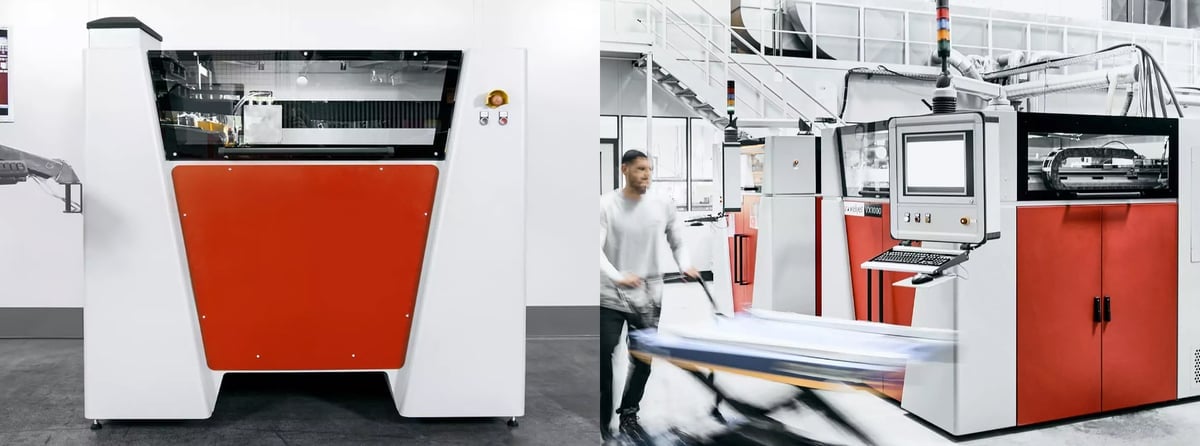
German company Voxeljet offers two industrial ceramic printers based on binder jetting technology.
The VX200 is capable of processing plastics and ceramics, while the VX1000 can process plastics, sand, and ceramics from medium-sized molds and cores for metal casting, to ceramic components.
The Voxeljet open-source software allows process parameters to be adapted to individual 3D printing materials.

Xjet
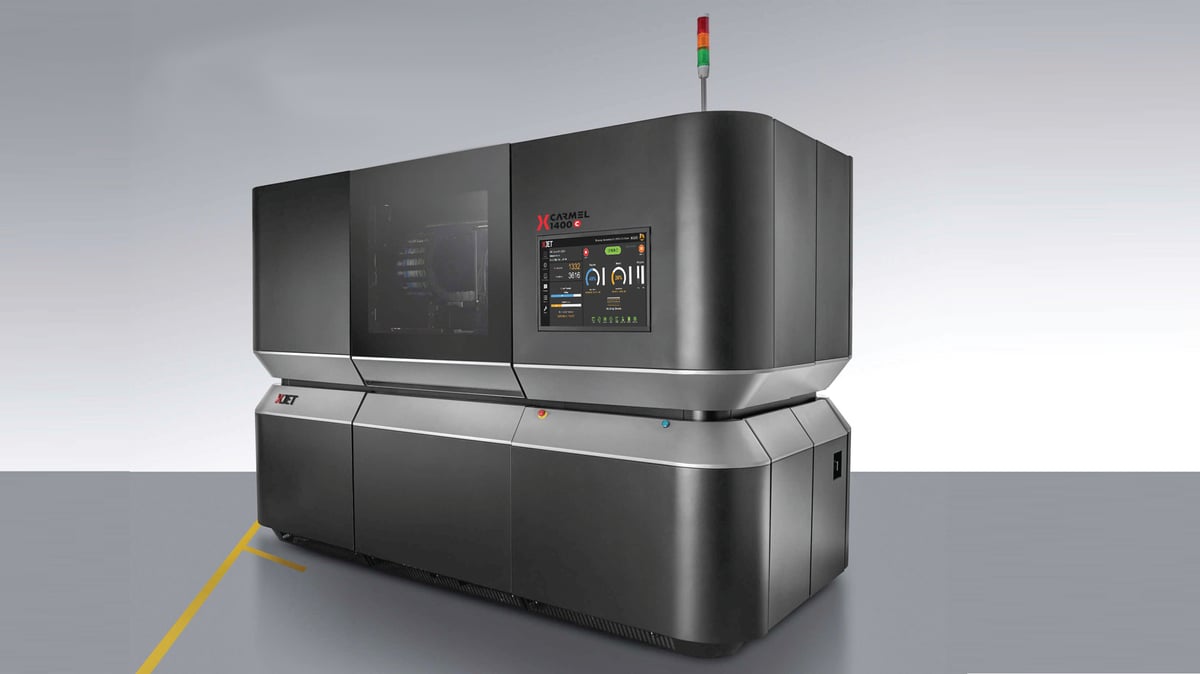
XJet takes a unique approach to industrial ceramic 3D printing with a material jetting technology the company calls NanoParticle Jetting. Unlike other ceramic printers, the Carmel 1400C does not use ceramic powder or a vat of ceramic slurry. Instead, a ceramic liquid material and a separate soluble support liquid are jetted onto the build plate through thousands of tiny ink jets.
Featuring a 1,400 cm² build tray, the Carmel 1400C enables the simultaneous production of multiple ceramic parts.
After printing, parts are moved into XJet’s SMART (Support Material Automatic Removal Technology) station, which automates the post-printing removal of the soluble supports. Lastly, parts undergo an overnight sintering process in a commercial oven.
XJet ceramic materials include zirconia and alumina in sealed cartridges.
Admatec
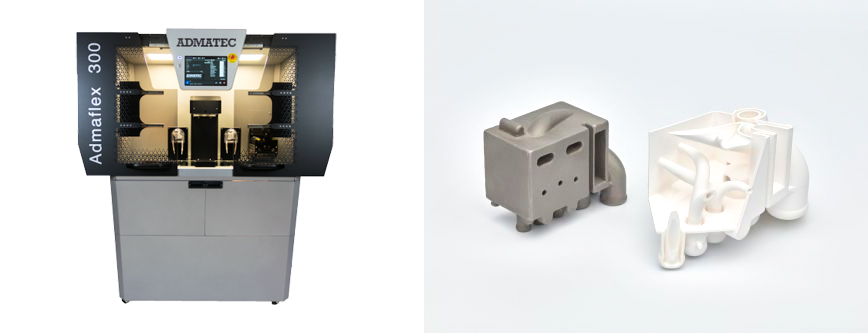
The Netherlands-based Admatec focuses on developing new 3D printing techniques for metal and ceramic materials.
Following the release of its first 3D printer, the Adamflex 130, in late 2019, the company unveiled its new ceramics printer: the Admaflex 300. It’s meant to produce large-scale parts while featuring a patented feedstock system and a vision-based system for in-process monitoring. The AdmaPrint feedstock is specially formulated with a mixture of photosensitive resins and a solid load of powder (either ceramic or metal), called slurry. The use of light curing and slurries produces parts with high resolutions and very fine surface roughness in printed products.
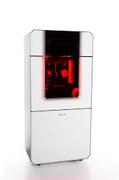

License: The text of "3D Printing Patterns, Cores & Molds for Casting Metal" by All3DP Pro is licensed under a Creative Commons Attribution 4.0 International License.
